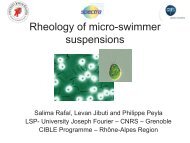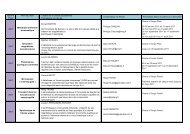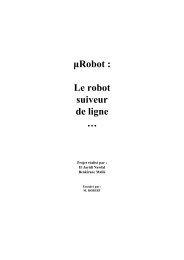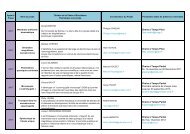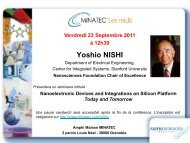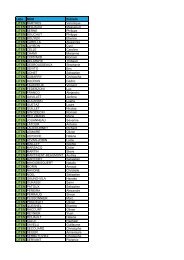2012 Thesis Prize Award Ceremony - Fondation Nanosciences
2012 Thesis Prize Award Ceremony - Fondation Nanosciences
2012 Thesis Prize Award Ceremony - Fondation Nanosciences
Create successful ePaper yourself
Turn your PDF publications into a flip-book with our unique Google optimized e-Paper software.
Olivier ARCIZET<br />
CNRS/UJF - Institut Néel<br />
Already 19 Grenoble-based researchers in the<br />
nanosciences field have received European grants<br />
‘ERC Starting Grant <strong>2012</strong>’<br />
Hybrid quantum Nano-optomechanics<br />
<strong>2012</strong><br />
Wiebke<br />
GUICHARD<br />
Institut Néel<br />
Olivier<br />
ARCIZET<br />
Institut Néel<br />
Jacek<br />
KASPRZAK<br />
Institut Néel<br />
Tristan<br />
MEUNIER<br />
Institut Néel<br />
The intense experimental efforts generated by several<br />
groups worldwide during the last 5 years have very<br />
recently culminated by demonstrating what the<br />
scientific community considered unconceivable only<br />
10 years ago: cooling a macroscopic mechanical<br />
oscillator down to its quantum ground state of motion.<br />
Various kinds of mechanical oscillators have now<br />
been prepared at ultralow mean phonon occupancy<br />
by combining traditional cryogenic and active cooling<br />
techniques, opening the road towards quantum<br />
nanomechanics. It is now time to envision even more<br />
challenging experiments aiming at engineering the<br />
quantum mechanical state of the oscillator. This can<br />
only be achieved by coupling the ultracold oscillator<br />
to a second system whose quantum state can be<br />
independently controlled and transferred onto the<br />
mechanical oscillator. The combination of these two<br />
components defines a “hybrid” mechanical system.<br />
This project aims at exploring the emerging field of<br />
hybrid quantum nano-optomechanics in a setting where<br />
both components of the system can be simultaneously<br />
monitored and controlled. Our goal is to investigate the<br />
hybrid coupling between a nanomechanical oscillator<br />
and a Nitrogen Vacancy defect in diamond.<br />
Olivier Arcizet received his PhD in 2007 from the<br />
Kastler Brossel Laboratory (Paris). After two years at<br />
Max Planck Institute for Quantum Optics in Garching<br />
as a post-doctoral scientist, he joined the Institut Néel<br />
in Grenoble where he’s pursuing his research on<br />
hybrid nano-optomechanics systems.<br />
http://ceremonie<strong>2012</strong>.eventbrite.com<br />
2011<br />
2010<br />
2009<br />
2008<br />
Stéphane<br />
REDON<br />
INRIA<br />
Eva<br />
MONROY<br />
INAC<br />
David<br />
COOPER<br />
LÉTI<br />
Max<br />
HOFHEINZ<br />
INAC<br />
Catherine<br />
PICART<br />
LMGP<br />
Bernard<br />
DIENY<br />
SPINTEC<br />
Vincent<br />
ARTERO<br />
iRTSV/LCBM<br />
Manuel<br />
THERY<br />
iRTSV/LPCV<br />
Silvano<br />
DE FRANCESCHI<br />
INAC<br />
Maxime<br />
RICHARD<br />
Institut Néel<br />
Thomas<br />
ERNST<br />
LÉTI<br />
Wolfgang<br />
WERNSDORFER<br />
Institut Néel<br />
Xavier<br />
WAINTAL<br />
INAC<br />
Marek<br />
POTEMSKI<br />
LNCMI<br />
Jean-Louis<br />
BARRAT<br />
LIPhy<br />
Starting GRANT<br />
Advanced GRANT



